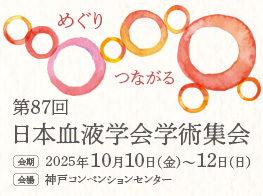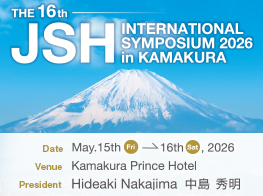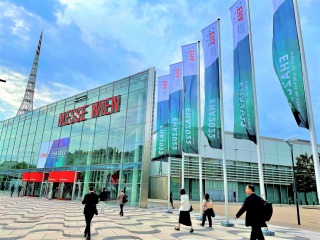
名前:木村 真衣子【岡山大学大学院 医歯薬学総合研究科】
発表形式:oral
Title:
ALTERATION OF BONE MARROW NICHE BY ALLOGENEIC IMMUNE REACTION AFTER HSCT
Authors:
Maiko Kimura* 1 , Noboru Asada2 , Masayuki Matsuda1 , Masaya Abe1 , Wataru Kitamura1 , Ken-ichi Matsuoka1 , Hideaki Fujiwara2 , Mitsuaki Ono3 , Wang Ziyi3 , Tomoyuki Mukai4 , Yoshitaka Morita5 , Yoshinobu Maeda1
Affiliations:
1. Hematology, Oncology and Respiratory Medicine, Okayama University Graduate School of Medicine, Dentistry and Pharmaceutical Science
2. Hematology and Oncology, Okayama University Hospital
3. Molecular Biology and Biochemistry, Okayama University Graduate School of Medicine, Dentistry and Pharmaceutical Science, Okayama
4. Immunology and Molecular Genetics
5. Rheumatology, Kawasaki Medical School, Kurashiki, Japan
Abstract:
Background: Allogeneic stem cell transplantation (allo-SCT) has been considered as a curable therapy for hematologic diseases. Post-transplant myelosuppression is one of the life-threatening complications. Hematopoietic stem cell (HSC) functions are tightly regulated by a specialized microenvironment called “niche” in the bone marrow (BM) and we have identified differential contributions of perivascular stromal cells as HSC niche (Asada et al. Nat Cell Biol 2017). Recent studies indicate that BM niche can be targeted by allo-immune reaction but it remains unclear how the perivascular niche cells are involved in the mechanism of HSC dysfunction after allo-SCT.
Aims: In this study, we aim to investigate the mechanisms of the impairment of the niche cells by allo-immune reactions, and to explore a targetable pathway for myelosuppression after allo-SCT.
Methods: To evaluate the alterations in niche cells after allo-SCT, we utilized allo-SCT mice models (C3H/HeJ into C57BL/6, C57BL/6 into B6D2F1). Hematopoietic cells, including HSCs and mature cells, and perivascular stromal cells in BM were analyzed by flow cytometry (FACS) after transplantation. In imaging studies, we visualized perivascular stromal cells using Nestin-GFP (Nes-GFP), Myh11-CreER/tdTomato, LeptinR-Cre/tdTomato transgenic mice and observed them with confocal laser scanning microscopy. The gene expression analysis of niche factors was performed by real-time PCR. To assess the landscape of transcriptional remodeling in BM after allo-SCT, we performed single-cell RNA sequencing (scRNAseq) of BM cells.
Results: FACS analyses showed that Nes-GFP+ stromal cells were dramatically reduced, and HSC recovery was severely impaired in allo-SCT mice compared to control mice at day 21 after SCT. Imaging studies also revealed that perivascular stromal cells are morphologically damaged in allo-SCT mice. Nes-GFP+ stromal cells in allo-SCT mice presented a decreased expression of niche factors, including Cxcl12 and Scf, which are essential for HSC maintenance, indicating the dysfunction of niche cells. We confirmed the impaired niche function in allo-SCT mice by tandem transplantation analysis in vivo, in which the recovery of syngeneic HSCs was also impaired in damaged microenvironment in allo-SCT mice. Prevention of allo-reactive T cell expansion by post-transplant cyclophosphamide ameliorated the niche cell reduction along with improved recovery of HSCs. These results indicate that niche impairment caused by allo-immune reaction leads to HSC dysfunction. The scRNAseq of BM highlighted the elevated expression levels of inflammation response genes, including Cxcl9 and Cxcl10, and MHC classⅡ, together with the deceased expression of niche factors in niche cells in allo-SCT mice. These alterations seemed to be induced by proinflammatory cytokines such as interferon-gamma (INF-γ) derived from allo-T cells, as the increased number of T cells and high levels of INF-γ in BM were observed in allo-SCT mice. Additionally, evaluation of T cell localization by using imaging techniques of BM revealed that allo-T cells reside significant closer to LepR+ niche cells in allo-SCT mice. Since activation of CXCR3, which is a receptor for chemokines Cxcl9 and Cxcl10, has been shown to induce chemotaxis of activated T cells, we treated allo-SCT mice with AMG487, an antagonist of CXCR3, resulted in an improved recovery of both perivascular niche cells and hematopoiesis in allo-SCT mice.
Summary/Conclusion: Collectively, allo-immune reaction severely damages perivascular HSC niche cells, leading to impaired recovery of hematopoiesis after allo-SCT.
Keywords: Allogeneic stem cell transplant, Graft-versus-host disease (GVHD), Stem cell niche
EHA2022参加レポート
この度はJSH Travel Award for EHA Congressにご採択いただき、誠にありがとうございました。2020年、2021年はCOVID-19の影響でオンライン開催でしたが、今年は現地とバーチャルとのハイブリッド開催の形式となりました。私も当初は日本からの発表になるものと予想していたのですが、オーラルセッションは現地開催のみとのことで、急遽現地に渡航しての発表となりました。
今年の開催はオーストリアのウィーンで行われました。初夏の爽やかな気候の中、ウィーンは比較的コンパクトな街の中に素晴らしい歴史的建造物や公園が凝縮されており、豊かで上品な雰囲気を感じました。
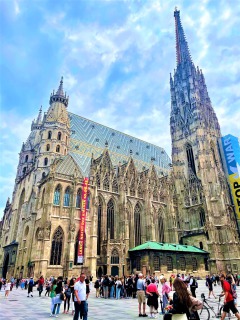
交通の便もよく、市電も地下鉄もバスも全て共通チケットで乗ることができ、また学会開催期間はフリーパスをいただけたので大変ありがたかったです。現地は予想以上に盛況で、大ホールがほぼ満員になるほどの参加人数でした。
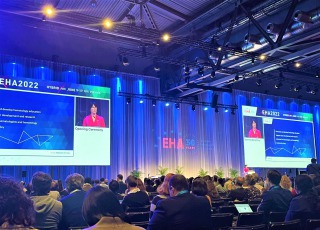
EHA参加は初めてでしたので過去との比較はできませんが、アジアからの参加はあまり多くない印象でした。
私は開催2日目のStem cells and their nicheセッションで口演発表させていただきました。初めての海外学会での発表でしたので緊張しましたが、セッション前の時間で司会のDr.SteidlとDr. Jordaを中心に発表者同士の顔合わせをしていただいたおかげで、和気あいあいとした雰囲気となり緊張もやや解れました。私は同種移植後に骨髄ニッチが障害され、造血幹細胞の数的、機能的低下がおこることに着目し、そのメカニズムとニッチ保護についての研究内容を発表しました。他の発表者のように流暢に発表することはできませんでしたが、たくさんの質問をいただけたことは嬉しかったですし、いただいたアドバイスから新たな着想を得ることができ、大変有意義な時間となりました。
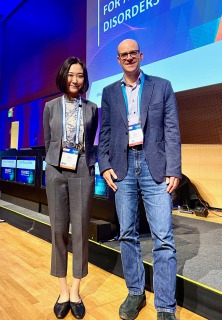
同セッションでは、骨髄組織のオルガノイド作製技術、炎症時の造血幹細胞分化の変容、骨髄間葉系細胞によるex vivoでのHSC expansionなど、臨床を見据えたアプローチをしているテーマが多く、同じ骨髄微小環境を研究している者として大変刺激を受けました。全体としては教育講演や若手医師・研究者によるディスカッション形式のセッション等が多く、若い医師の育成に力を入れている印象を受けました。また、EHAでは、環境への配慮が行き届いている点も印象的でした。入り口で希望者のみに小さな学会パンフレット1冊が渡されるほかは何もなく、企業ブースでも広告を渡されることはほとんどありませんでした。ランチもバイキング形式で、自分が食べられる分のみをお取りくださいといったスタイルで、日本でも参考にしたい工夫が随所に見受けられました。
今回このような貴重な機会をいただき、日本血液学会国際委員会、事務局の皆さまには心より感謝申し上げます。また、COVID-19の影響がまだ残る中、貴重な機会だからと後押ししてくださった前田先生をはじめ、日頃より熱心にご指導いただいております淺田先生、医局の先生方、感染対策委員の先生方には、この場を借りて深く御礼申し上げます。

